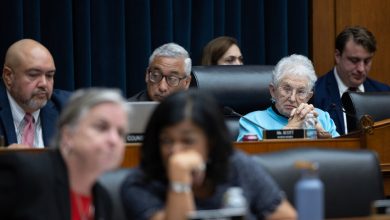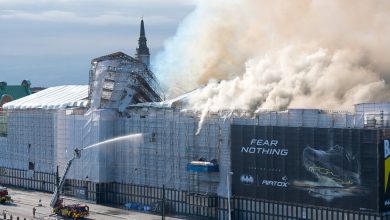In Talks on Ukraine, U.S. and Russia Deadlock Over NATO Expansion

GENEVA — The United States and Russia emerged from seven hours of urgent negotiations on Monday staking out seemingly irreconcilable positions on the future of the NATO alliance and the deployment of troops and weapons in Eastern Europe, keeping tensions highamid fears of a Russian invasion of Ukraine.
Deputy Foreign Minister Sergei A. Ryabkov, Russia’s lead negotiator, insisted after the meeting that it was “absolutely mandatory” that Ukraine “never, never, ever” become a NATO member.
His American counterpart, Deputy Secretary of State Wendy Sherman, reiterated that the United States could never make such a pledge because “we will not allow anyone to slam closed NATO’s open door policy,” and she said that the United States and its allies would not stand by if Russia sought to change international borders “by force.’’
The impasse left the fate of Ukraine — which was not invited to the bilateral talks — in a state of uncertainty, with Russia’s military intentions far from resolved following hastily-scheduled meetings between Ms. Sherman and Mr. Ryabkov on Sunday night and on Monday.
Still, while Russia has massed roughly 100,000 troops on its borders with Ukraine, Mr. Ryabkov told reporters “we have no intention to invade Ukraine.” And both sides offered some positive assessments.
Ms. Sherman, talking to reporters via phone after Monday’s meeting, said that she saw some areas where the two countries could make progress, and Mr. Ryabkov described the talks as “very professional, deep, concrete” and that their tone “makes one more optimistic.’’
The talks will continue on Wednesday in Brussels, when Russian officials meet with NATO allies, and on Thursday in Vienna, at a gathering of the Organization for Security and Cooperation in Europe, which includes both Russia and Ukraine as well as the United States. Mr. Ryabkov said that the outcome of those discussions would determine whether or not Russia was willing to proceed with diplomacy.
And he warned that if the West did not agree to Russia’s demands to roll back NATO’s presence in Eastern Europe, it would face unspecified consequences that would put the “security of the whole European continent” at risk.
The ambivalent messaging from Mr. Ryabkov, alternating between cautiously conciliatory and vaguely threatening, dovetailed with new assessments about Russia’s timetable for possible intervention in Ukraine, with American officials remaining deeply concerned about a possible invasion.
But Russian forces in Ukraine have not increased in recent weeks as much as intelligence officials predicted a few weeks ago, American officials told The New York Times, signaling that President Vladimir V. Putin of Russia still may not have made up his mind about whether to proceed with an attack, or might be considering something less conventional than pouring troops over the border.
The U.S. officials say they are preparing for everything from a full-scale invasion, to partial incursions, to cyberattacks intended to paralyze the country.
“He tried to maintain a flexible position that would allow Putin to decide either way,” Kadri Liik, a Russia specialist at the European Council on Foreign Relations in Berlin, said of Mr. Ryabkov’s approach. “It will be Putin’s decision whether to continue these talks under the conditions that the U.S. makes available.”
Russia annexed the Ukrainian peninsula of Crimea and fomented a separatist war in the country’s east after the pro-Western revolution in Kyiv, Ukraine’s capital, in 2014. The war in eastern Ukraine continues to simmer, having claimed more than 13,000 Ukrainian lives on both sides.
In the last year, Mr. Putin has increasingly cast Western support for Ukraine as an existential threat, claiming that the neighboring country, formerly a Soviet republic, was being turned into an “anti-Russia” that the West could use to attack or otherwise weaken his country.
But Russia’s aims go far beyond the future of Ukraine, a position it put forth in an extraordinary set of demands to the West last month that sought to roll back NATO’s military presence to 1990s levels. It also asked for guarantees that NATO would not expand eastward or keep forces or weapons in former Soviet states that have since joined NATO. .
On Monday, American officials said they saw openings for deepening the conversation with Russia — for instance on reviving the Intermediate-Range Nuclear Forces Treaty, which the United States abandoned in 2019, after years of accusing Russia of violating its terms. The treaty prohibited the deployment of missiles that can deliver a nuclear strike with next to no warning.
In Monday’s talks, the American side included some ideas around restrictions on where the United States and Russia could locate their missiles.
Right now, the United States has no intermediate-range missiles in Europe, so agreeing to ban them again would be easy, experts say. But for decades it has kept a range of tactical nuclear weapons in Belgium, Italy, Germany and Turkey, and Russia could request that those be banned as well.
Ms. Sherman, who served in the Clinton and Obama administrations and has often been handed some of the United States’ hardest negotiations, said she made clear that Washington is open to discussing “ways we can set reciprocal limits on the size and scope of military exercises and to improve transparency about those exercises.”
That would be a way of trying to get Russian forces away from Ukraine’s borders.
“The United States is committed to meaningful reciprocal dialogue with Russia,” Ms. Sherman told reporters on Monday, underscoring the Biden administration’s strategy to maintain diplomatic engagement with Russia in order to avoid war. “We must give diplomacy and dialogue the time and space required to make progress on such complex issues.”
Understand the Escalating Tensions Over Ukraine
A brewing conflict. Antagonism between Ukraine and Russia has been simmering since 2014, when the Russian military crossed into Ukrainian territory, annexing Crimea and whipping up a rebellion in the east. A tenuous cease-fire was reached in 2015, but peace has been elusive.
A spike in hostilities. Russia has recently been building up forces near its border with Ukraine, and the Kremlin’s rhetoric toward its neighbor has hardened. Concern grew in late October, when Ukraine used an armed drone to attack a howitzer operated by Russian-backed separatists.
Ominous warnings. Russia called the strike a destabilizing act that violated the cease-fire agreement, raising fears of a new intervention in Ukraine that could draw the United States and Europe into a new phase of the conflict.
The Kremlin’s position. President Vladimir V. Putin of Russia, who has increasingly portrayed NATO’s eastward expansion as an existential threat to his country, said that Moscow’s military buildup was a response to Ukraine’s deepening partnership with the alliance.
A measured approach. President Biden has said he is seeking a stable relationship with Russia. So far, his administration is focusing on maintaining a dialogue with Moscow, while seeking to develop deterrence measures in concert with European countries.
Even without any American concessions, Monday’s talks already represented a victory of sorts for the Kremlin because they brought the issue of NATO expansion, which has long angered Mr. Putin, to the forefront of issues confronting Washington policymakers.
Ms. Liik, the analyst, said the seriousness with which the United States appeared to prepare for Monday’s talks — sending a large delegation that included officials from the Defense Department, the State Department and the National Security Council, which coordinates policy at the White House — sent an important signal to Moscow.
“We had the feeling that the American side took the Russian proposals very seriously and studied them deeply,” Mr. Ryabkov said. “Now, things are being called by their names, and this in itself has a healing effect on our relations with the West.”
Mr. Ryabkov said Russia would make a decision on whether or not to continue diplomacy after the meetings this week, warning that “the risks connected with a possible intensification of confrontation cannot be underestimated.”
But Mr. Ryabkov was vague as to what, exactly, the consequences would be if the United States refused Russia’s demands. He repeatedly said that Russia had no plans to attack Ukraine and that there was “no reason to fear an escalation scenario in this regard.”
But he also said that increased military activity by the West in Ukraine and in the Black Sea region had caused Russia to shift its military posture in the region, and that it was concerned about “deliberate provocations” by Ukraine.
Western officials have said they believe that Russia could manufacture a “provocation” as a pretext for an invasion.
Describing the consequences of what would happen if diplomacy fails, Mr. Ryabkov repeated Mr. Putin’s wording that the West would face a “military-technical response” by Russia. He said Russia would not make public what that response would look like because doing so would invite new sanctions threats, but he indicated it could involve new deployments of certain weapons systems.
Ms. Sherman, cautious after a long career of sparring with Russian officials, was asked after the meeting whether she had realistic hope for a diplomatic solution.
“It’s very hard for diplomats to do the work we do if you have no hope,’’ she said. “So of course I have hope.”
She paused briefly. “But what I care about more is results.”




